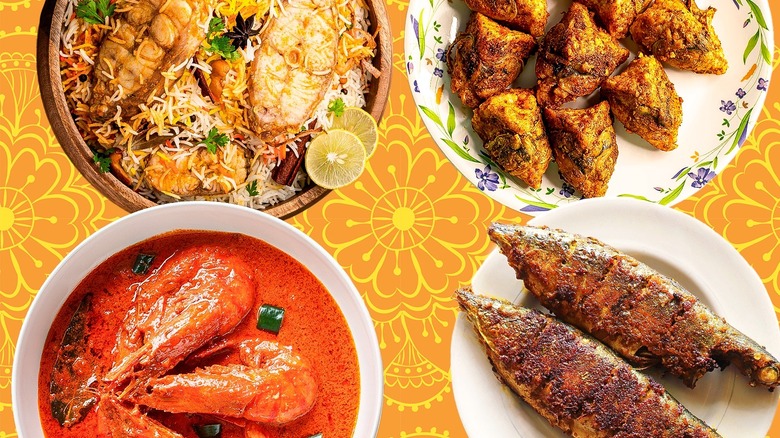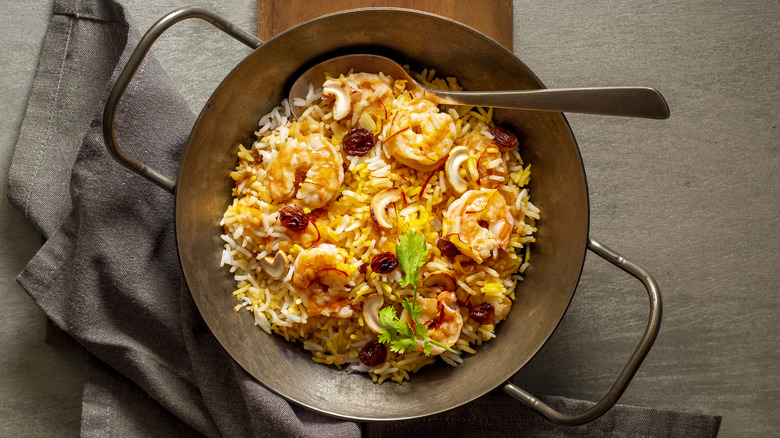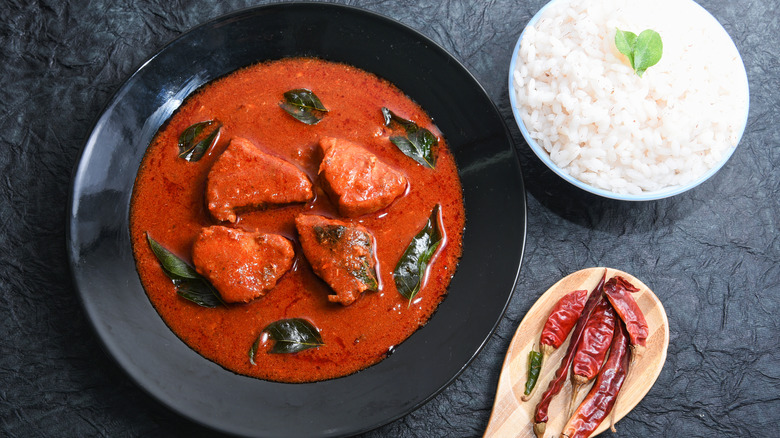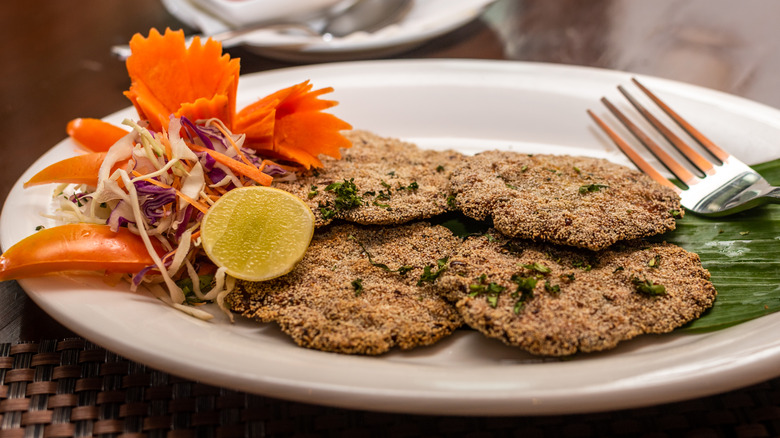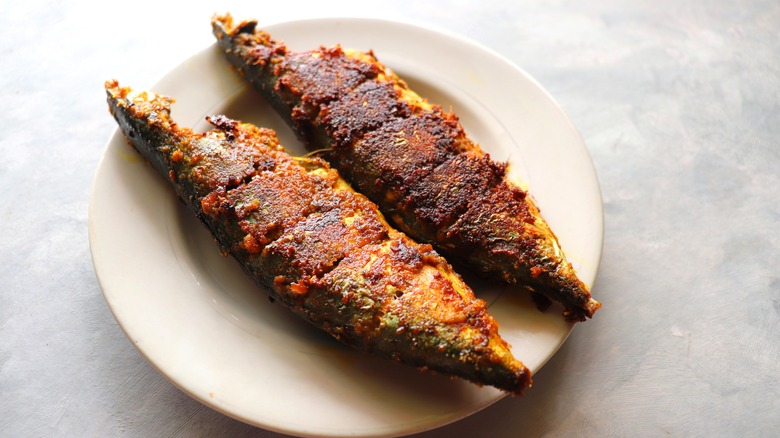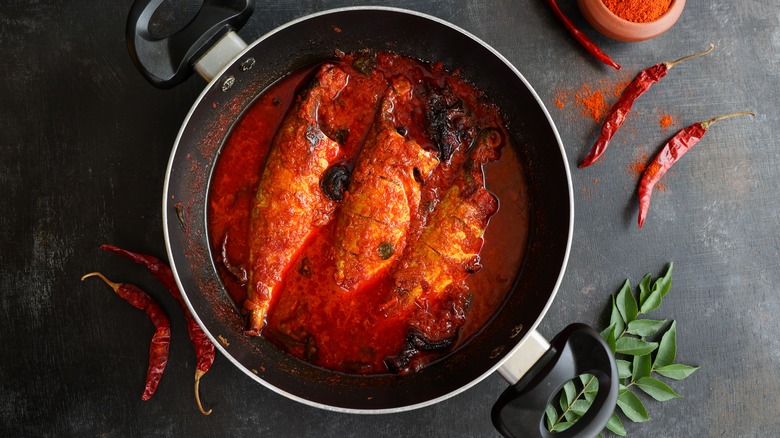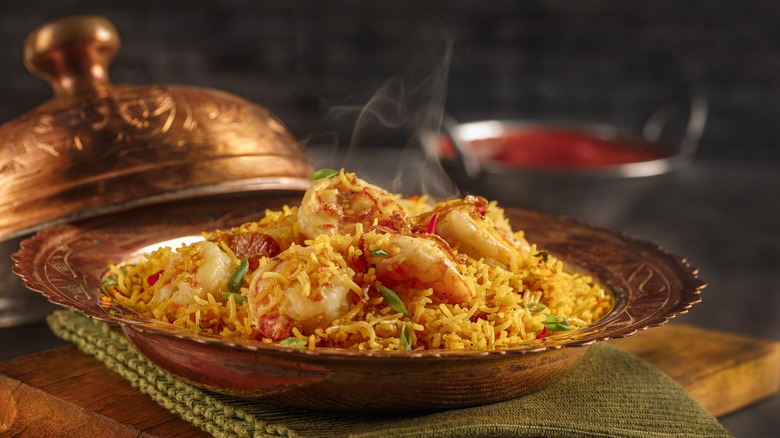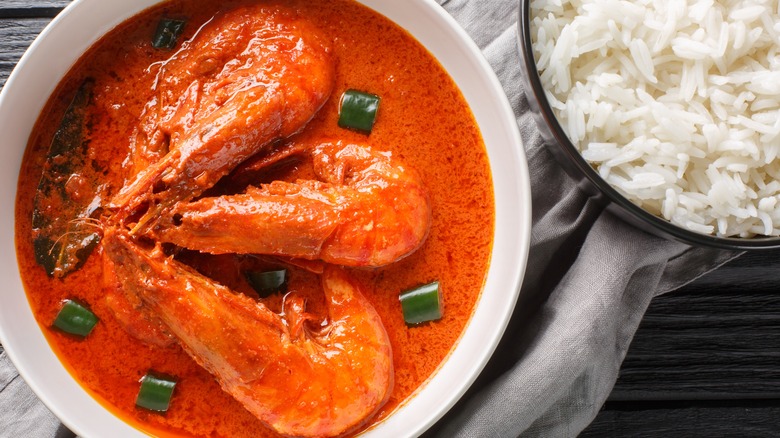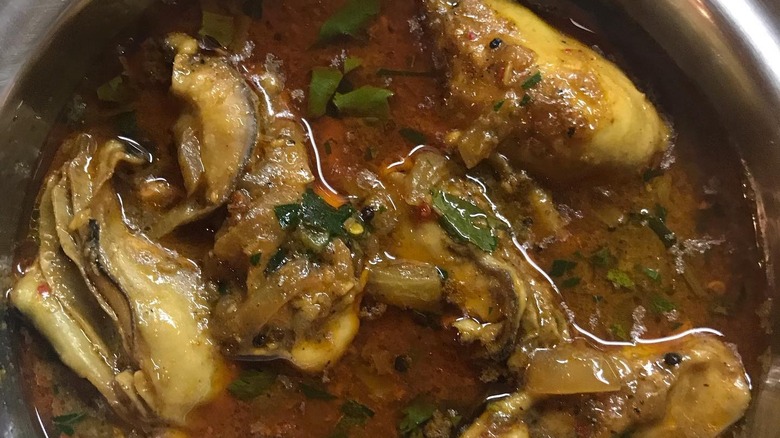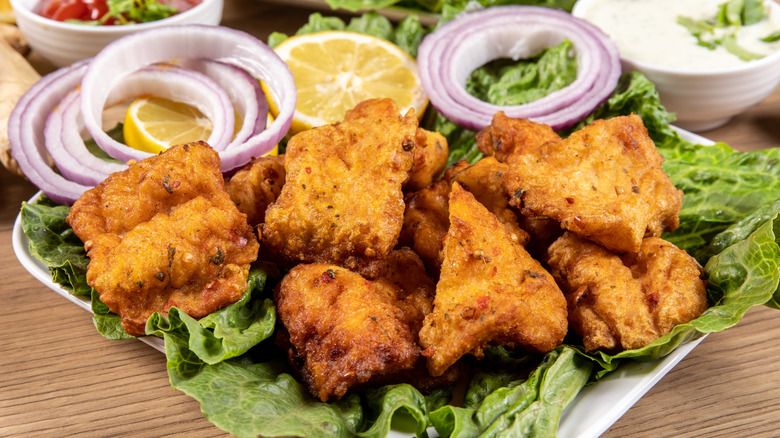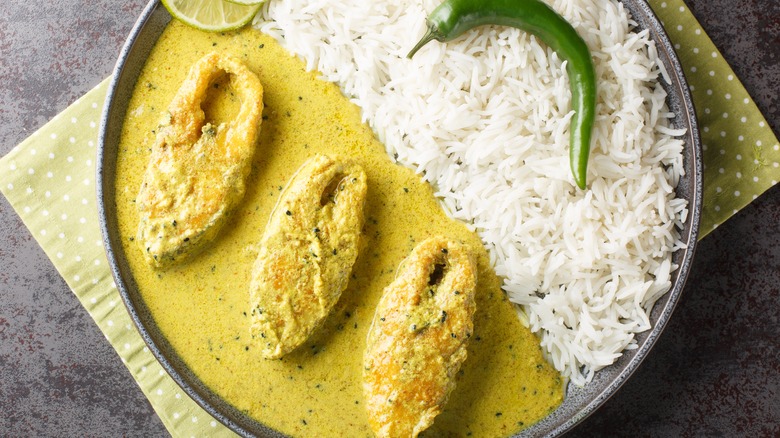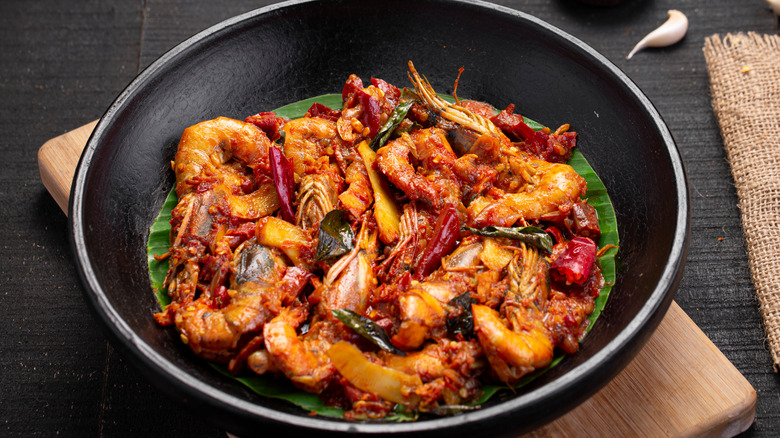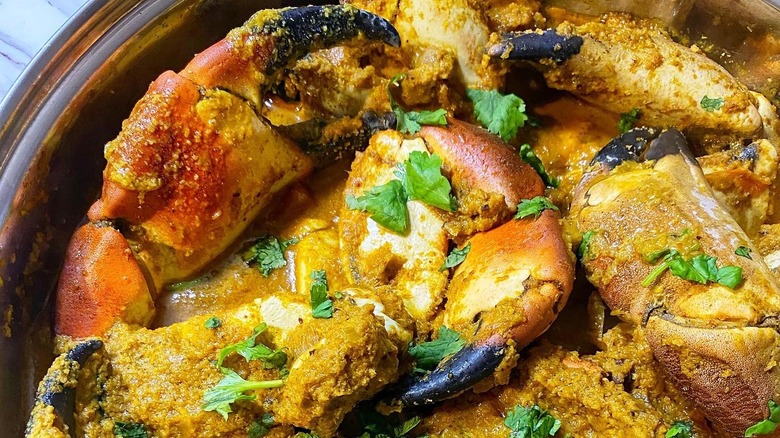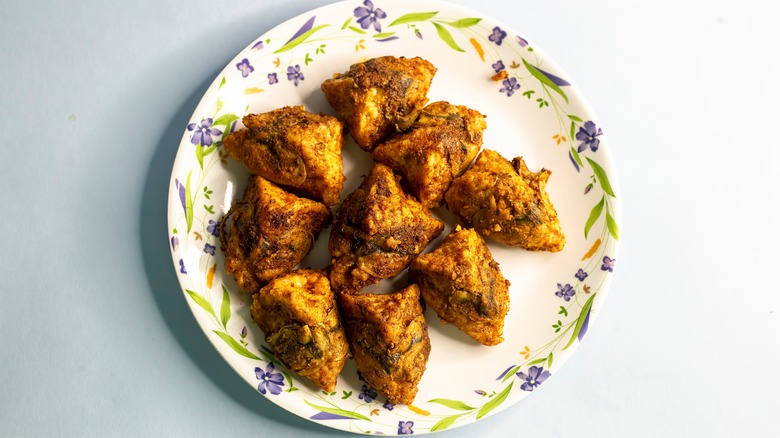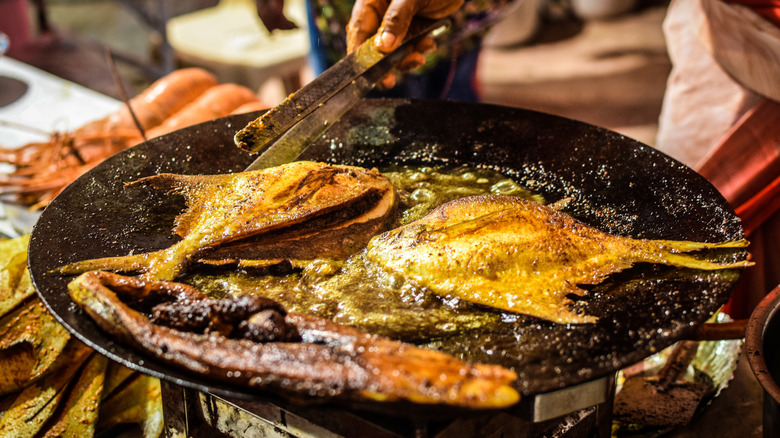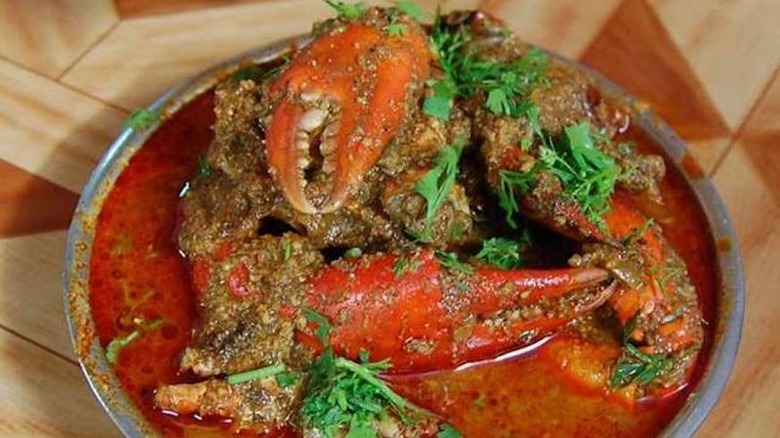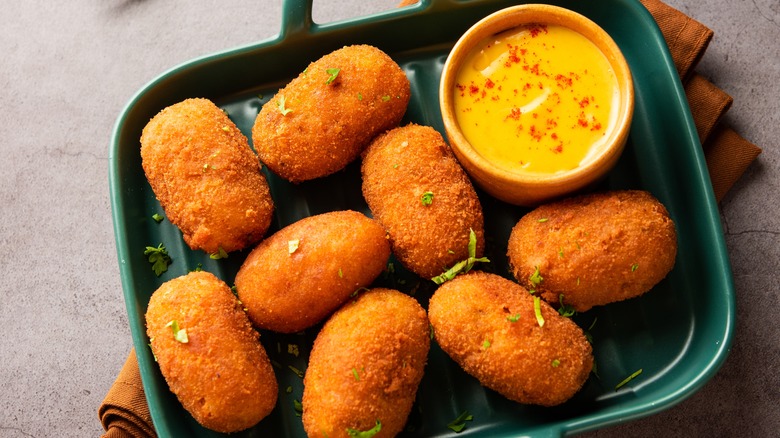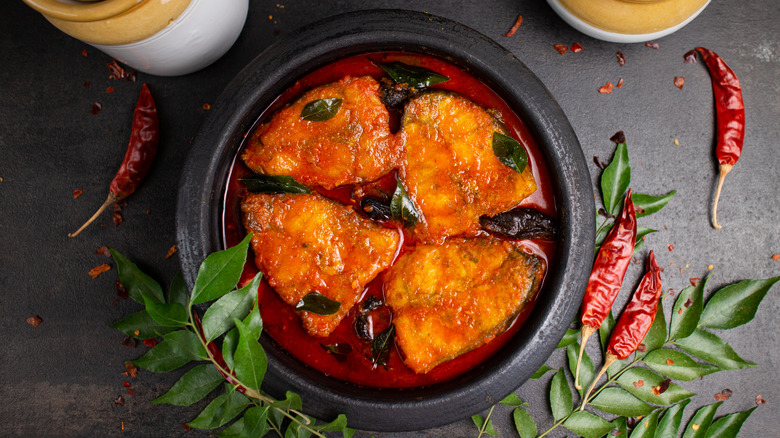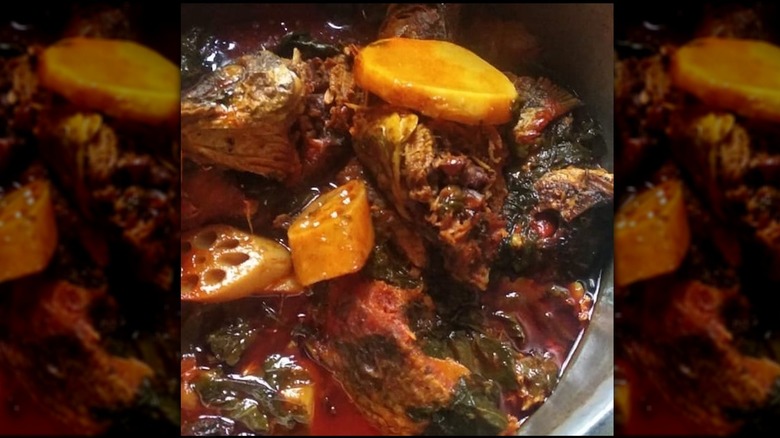20 Indian Seafood Dishes You Have To Try At Least Once
India has an expansive coastline, which means an extensive repertoire of delicious seafood dishes ready to be devoured. Virtually every little village and city all across India's shore has hidden gems of regional cuisine to offer the intrepid traveler, from the ancient fishing villages of Mumbai, the sunny beaches of Goa, coconut palm-lined paths of Tamil Nadu, and tiny delta islands of West Bengal. That's not to mention the river-dense areas of Kashmir or the backwaters of Kerala, which host a myriad of tempting dishes using freshwater fish.
However, this list won't just cover fish — we're featuring enviable plates using everything from shellfish and crustaceans to accessible options like salmon or mackerel. And don't expect just curries, as Indian cuisine expands far beyond the elaborately spiced saucy dishes we know and love. You'll find seafood features in much more: crispy fried snacks, rice dishes with the longest, fluffiest grains you've ever seen, piquant pickles, and much more.
Whether you'll use your newfound knowledge of unmissable Indian seafood dishes to cook up a storm in the comfort of your own home, seek out restaurants serving the diverse dishes, or if you're ultra-lucky and are planning a trip to India, you'll find endless inspiration below. Let's dive in ... pun intended!
Kolambi bhaat
Explore beyond biryani and discover India's rich array of sumptuous rice dishes, starting with Maharashtrian kolambi bhaat. In Marathi, the language spoken in the region, kolambi means prawns, while bhaat refers to rice.
In true Indian fashion, the dish is highly spiced, featuring long, fluffy, and highly aromatic grains of basmati rice cooked with juicy marinated prawns, a base of onions, fragrant whole spices, sour tomatoes, zesty curry leaves, and for an authentic Maharashtrian touch, a regional spice powder known as "goda masala," a sweet-scented potent and spicy mixture.
Kolambi bhaat boasts a simplified one-pot cooking method, making it easy to whip up yourself. If you'd prefer to have the dish cooked for you, you may struggle to find the regional delicacy outside India. It's widespread throughout Maharashtra but especially beloved in the coastal Konkan region, where cooks garnish it with freshly harvested coconut.
Maacher jhol
West Bengal (and the neighboring country Bangladesh) is well-known for its seafood-heavy cuisine. Perhaps the area's most ubiquitous dish is maacher jhol (roughly translating to "fish gravy"), a striking red-colored dish with the distinctive flavor of mustard oil and Bengali spicing.
Maacher jhol traditionally uses freshwater carp like rohu or ilish, the latter of which is the state fish of West Bengal. Other oily fish like mackerel or kingfish make for an excellent substitute. Aside from the fish, the secret is in the sauce, or gravy, as it's known in India. Thin and watery, don't be mistaken by thinking it lacks flavor; minimal spicing lets the punchy, fruity taste of chili powder shine, while optional panch phoron offers bursts of flavor. Plus, the fiery, wet curry perfectly complements steamed rice.
Tisryache dangar
Goa is so much more than beaches and parties. Next time you visit the sun-soaked state, dive into the cuisine and ask for recommendations from locals. One of the dishes that comes to mind as completely indispensable is tisryache dangar, or Goan clam cutlets. Luckily, even if there's no trip to India on your horizon, this dish is easy to recreate at home.
It's as simple as this: Sweet, salty, and slightly chewy clams mixed with fresh coconut, punchy onions, earthy spices, lemony cilantro, hot green chilis, and rice or garbanzo bean flour to bind everything together. Formed into small patties and coated with breadcrumbs, the cutlets are fried until crispy and golden brown, then relished on a platter alongside fish curry, rice, and salad.
Rava fry
Despite the common misconception, Indian cuisine extends far beyond curries, and rava fish fry exemplifies the country's culinary diversity. Prevalent across coastal southwestern India, the dish graces dining rooms and restaurant menus across Goa, Maharashtra, Karnataka, and Kerala. Each province has a slightly different method of preparation and spicing, but each has two necessary components: fish and semolina (rava).
Fresh kingfish (king mackerel) fillets or pomfret are the number one choice for cooks, typically marinated in a blend of basic spices like turmeric, red chili, and coriander powder, along with a ginger, garlic, and vinegar paste to ensure the semolina coating adheres well to the fish. Once shallow-fried, the rava-coated fish is deliciously crispy. For the complete experience, try eating it alongside rice, dal, or tangy rasam.
Ayala mulakittathu
Ayala mulakittathu is a dish hailing from northern Kerala, an area lush with green rolling hills, peaceful backwaters, and tropical sandy beaches. It showcases the best of Keralan cooking, with a lip-smackingly sour and spicy sauce. The star is mackerel (ayala), a fish in demand for its mild taste with mellow umami notes and tender flesh.
As with many Indian recipes, the base starts with sauteeing ginger, garlic, and green chilis in buttery coconut oil before adding a paste of tomatoes, pearl onions, and dried spices. Keralan cooking stands out for its bold use of black pepper along with dried chili powder and milder fresh green chilis for heat; the pepper offers a sharper, more citrusy heat, which balances well with flavors of curry leaves and souring agents like tamarind or brindle berry.
Seafood biryani
Biryani is the crowning glory of all Indian rice dishes. Equally popular outside South Asia, the glorious dish is made by layering fragrant long-grain rice with crispy caramelized onions, marinated protein or vegetables, fresh herbs, and nuts. Plus, our top tip? Bloom your saffron in milk and pour it over the rice for more flavorful biryani.
Most recipes online suggest celebratory lamb biryani, hot and spicy chicken biryani, or a lighter vegetarian plate. While each of these variations deserves its claim to fame, seafood biryani is a hidden gem we think you should know about (and try).
Slow-cooked and gently perfumed, but with seafood instead of meat or vegetables, it's the cook's choice when choosing the main ingredient: Asian sea bass, mussels, shrimp, snapper, crabs, or even scallops are worthy additions. Serve with a fresh yogurt raita.
Chingri malai
We all know coconut and shrimp are a match made in heaven. In the U.S., the enduringly beloved pan-fried coconut shrimp flies off the restaurant pass. In India, it's no different — except there's a slight difference in how the flavor combinations meld together.
Additionally, there's good news for those who want to immerse themselves in Indian cuisine but find most dishes too spicy. Chingri malai approximately translates to "creamy shrimp," with chingri meaning shrimp in Bengali and malai translating to cream. However, the recipe calls for simmering the shrimp in coconut milk, not dairy cream, leading some to theorize the name indicates the dish has influences in Malaysia (Malay).
Because shrimp possess a singularly delicate flavor, the mellow essence of coconut milk highlights their natural sweetness. Meanwhile, aromatic whole spices, such as bay leaves, green cardamom, and cloves, lend a beautiful subtle warmth to the plate.
Kalwanche tonak
Lavish and deeply rich, Konkani kalwanche tonak—which translates to "gravy of oysters" or oyster curry—is a dish to behold. Similarly to the U.S., oysters are considered a delicacy in India. In the Konkani region, where traditional livelihoods revolve around fishing communities, men and women alike harvest oysters to sell in markets.
The dark brown color of kalwanche tonak comes from a special Konkani masala paste made with onion, garlic, fresh coconut, dried chilis, and aromatic spices such as coriander seeds, cloves, star anise, peppercorns, fennel seeds, cardamom, cinnamon, and stone flower (a lichen spice). The mixture is slowly dry-roasted to extract its aromatic oils, then ground into a paste and fried until caramelized before adding the cleaned oysters. Simmered until thick and irresistible, this is a must-try.
Amritsari fish pakora
Crispy, nutty, and irresistibly addictive — pakoras are the ultimate Indian appetizer, and you won't be able to stop at just one. The moreish snacks achieve their characteristic nutty flavor from besan (finely ground garbanzo bean flour) flavored with thyme-scented ajwain, ground spices, and fresh coriander. Mixed into a thick batter with finely sliced vegetables or chunks of protein, they're deep-fried until gloriously crunchy, then dunked into vibrant chutneys.
Despite Amritsar in northern Punjab not sharing a border with the sea, the city is renowned for its battered fish dish. You'll find everyone from street-side vendors, sit-in restaurants, hotels, and humble home cooks carefully frying the crunchy pieces (although air-fried pakora is becoming more trendy). Most use sole or river catfish, although Asian sea bass is a good alternative.
Machh kasundi
Loaded with numerous unusual ingredients, Bengali machh kasundi champions the flavor of mustard. Like most Bengali recipes, cooks use mustard oil in every cooking stage, but this dish adds an extra punch of sharp, hot mustard with kasundi, a sauce made from fermented mustard seeds pounded with dried spices. The sauce is widely available commercially, but some home cooks still prefer to make it themselves, sometimes incorporating sour-dried hog plums or mangoes to amplify its tangy flavor.
Other flavors may include nutty ground poppy seeds, green chilis, subtly bitter nigella seeds, onion, garlic, and thick yogurt. There are few dried spices needed to make the dish since the pungency of the fermented mustard sauce does all the talking; the secondary flavor should come from the fish, which is traditionally either salmon, Asian sea bass, ilish, or rohu.
Mangalore prawn ghee roast
Of all the dishes you can find in Mangalore, a large coastal city in the south Indian state of Karnataka known for its cultural importance and fantastic food, ghee roast has to be the most celebrated. Ghee roast potatoes, paneer, chicken, and yes — the dish we're highlighting today, prawn ghee roast — are iconic to the area.
Notoriously spicy and vivid red, you'll often find the dish served on a fresh banana leaf alongside super soft Indian roti or piping hot rice. It's packed with diverse Indian ingredients from the southern region, including yogurt and lemon-marinated prawns; a masala stuffed with whole seeds and spices, including fenugreek and a mainstay of the cuisine, tamarind; and a sprig of fresh zesty curry leaves.
Furthermore, as its name implies, the dish involves cooking prawns and spices in generous amounts of ghee. What is ghee? It's a form of clarified butter with a distinctly rich and nutty taste widely used in Indian cuisine, giving this dish an unforgettable touch.
Crab xacuti
Unjustifiably so, crab xacuti has far less visibility outside Goa than its other counterparts, mutton, beef, or chicken xacuti. Pronounced "sha-coot-ie," the dish may have Portuguese influences — as does much of West Indian cuisine, as the Portuguese colonialists brought potatoes, chilis, and many more ingredients to the country — but the flavors are now recognized as undeniably Goan.
Goan cooks use blue swimmers or freshwater mud crabs to make the dish, relying on the "catch of the day." The sweet, almost nutty flavor of the crab flesh marries with the sauce made from dry roasted coconut, poppy seeds, and the fragrance of cloves, cinnamon, and star anise while contrasting with the tart, caramelized hints of tamarind. Crab xacuti isn't overtly spicy, but it typically uses three varieties of pepper: dried mild chilis, fresh and sharp green chilis, and woodsy black pepper, lending a unique heat to the palate.
Kallummakaya nirachathu
For this recipe, we'll be traveling to the small fishing villages doting the Malabar coastline, where fresh mussels are caught every day, only to be sold, taken home, and cooked over an open fire. With its breathtaking landscapes, it is no wonder the Keralan region attracts legions of tourists — and if you find yourself there, don't miss the chance to try kallummakaya nirachathu (stuffed mussels). Interestingly, the dish goes by the moniker in the southern Keralan region: arikkadukka.
Immensely rewarding yet fiddly to assemble yourself, the dry dish has minimal spicing but an intricate technique. After cleaning the fresh mussels, chefs stuff the shells with a thick dough of ground par-boiled rice, coconut, onion, and fennel, then steam them until the mixture is aromatic and firm. The next step is removing the shells and marinating the mussels with a spicy concoction before frying them until golden.
Bharla paplet
Pomfret, a delicate-tasting fish with a buttery flavor and texture, is one of the most sought-after fish in Maharashtra, where, in the local language, it's known as "paplet." In particular, the fishing communities of Mumbai — which settled in the area long before the skyscrapers and daily bustle of India's commercial capital rose — are known for the mouthwatering bharla paplet, or stuffed pomfret.
Clean and fresh flavors dominate the palate, with a bright green masala paste made from fresh cilantro, lemon, green chilis, and grated coconut infusing every bite with herby vibrancy. While Indian seafood dishes make ample use of the marination technique to imbue extra flavor, they avoid the biggest marinating mistake, leaving the fish just long enough to soak up that spicy goodness.
Fish molee
The mild, comforting profile of Keralan fish molee (just as frequently spelled molly or moilee) is a standout worth writing home about. Despite Keralan food typically enjoying a reputation for mouth-burning heat, fish molee is creamy, nutty, peppery, and full of the intense citrusy aroma of curry leaves. No wonder the dish is lauded as a visitor's must-try and remains a mainstay on the locals' tables.
If you get the chance, try assorted fish options in molee; therachi (whiptail stingrays), pearlspot cichlids, and pompanos are among the best choices. And as for sides? The golden turmeric-hued stew tastes phenomenal soaked up with rice, fresh rice noodles (idiyappam), or fermented rice and coconut pancakes called appam.
Khekdyacha rassa
Crab meat is distinctly sweet and nutty, with an inviting buttery and tender texture that makes it hard to resist. Adventurous food connoisseurs will no doubt have savored the shellfish in pasta dishes like crab ravioli, but perhaps you shied away from pairing the light, subtle flavors with the heady spice of Indian food. If so, you're in for a treat.
Maharashtrian khekdyacha rassa — rassa being a thin, spicy gravy, and khekada being crabs — is full of the tropical flavors of the sea famed in the Malvani region. Key to the recipe is a smoky paste made from flame-roasted coconut, onion, herbs, and spices, which helps to thicken the sauce and lends a distinct nuance to the dish. Tamarind pulp provides tangy undertones to contrast the sharp picante kick from chili, while a regional spice blend called Malvani masala balances everything out.
Macher chop
Some recipes transcend worldwide borders, and croquettes happen to be one. The macher chop (or machh'er chop) is the Bengali version of the eminent snack food, boasting a deep golden breading hiding soft fish seasoned with carefully layered spices. However, unlike many other croquettes, this recipe doesn't always contain potatoes. Some chefs opt to let the fish do all the talking, while others prefer to encase the seafood in a layer of fluffy mashed potatoes before coating it in egg and breadcrumbs.
Authentically, people dip the macher chop in kasundi, a beloved Bengali fermented mustard sauce that makes its way into any snack platter. Surprisingly, though, ketchup or chutney is also acceptable. Plus, we recommend a fresh salad to lighten the fried food.
Sukha bomblache lonche
It's no secret that seafood can emit a strong aroma, but Bombay duck takes the prize for its exceptionally pungent smell. Despite its intense odor, cooks prize this ingredient for its salty, umami-rich taste. And, contrary to its name, you'll probably never guess what Bombay duck actually is. (Hint: It is a fish, after all.)
Often used dried, this dry Bombay duck pickle recipe, or as it's called in Marathi, sukha bomblache lonche, is no different. Unlike most pickles, this one is cooked by softening onions, garlic, ginger, and dried bombay duck pieces in oil before adding a vibrant spice containing pickling spices, vinegar, and sugar. It must be left to mature, then enjoyed on the side of a traditional Maharashtrian fish thali.
Chettinad fish curry
Of all the regions in India's southernmost state, Tamil Nadu, Chettinad is likely the most celebrated. No less so for its fish curry, which exemplifies Tamil cooking with its slow-cooked, richly savory paste of shallots, garlic, sour tomatoes, coconut, fennel, and black pepper fried in nutty gingelly (sesame) oil, alongside fenugreek seeds, curry leaves, chilis, tart tamarind, and dried spices. Let all those flavors soak into the Spanish mackerel, and you have a tantalizing medley of flavors. Other fish varieties are sometimes substituted, but seer fish (Spanish mackerel) is preferred.
When we think of Indian food as having incredibly complex yet flawlessly balanced spices, this dish is the poster child. It's spicy yet with enough sour aftertaste from tamarind or raw mango to cut through the heat and laden with woody, zesty subtleties.
Muji gaad
You might have noticed that Indian seafood dishes typically solely showcase sea proteins as the main attraction. However, breaking away from the norm, this spectacular Kashmiri dish promises to provide something excitingly different to the taste buds.
Muji gaad combines deep-fried fish (customarily trout) with peppery fried radish, each swimming in a fragrant sauce seasoned with earthy black cumin seeds, fennel powder, ginger powder, warming Kashmiri chili powder, and an array of other delights. As recipes vary, some chefs will add lotus roots, another popular component of Kashmiri cooking, and leafy greens such as bitter bishop's weed or the more globally available collard greens.
Culturally, the dish is especially linked to the Hindu community of Kashmir, although it features heavily on both Muslim and Hindu festive occasions. We suggest eating it with a side of steaming hot rice.
